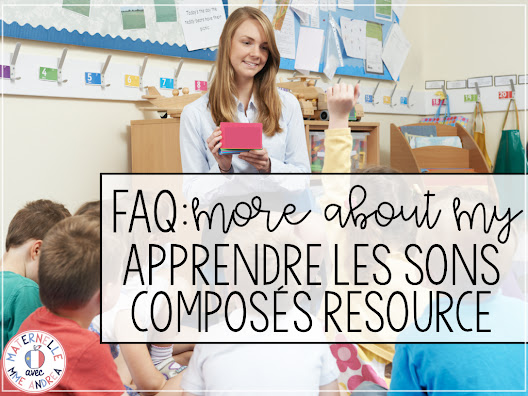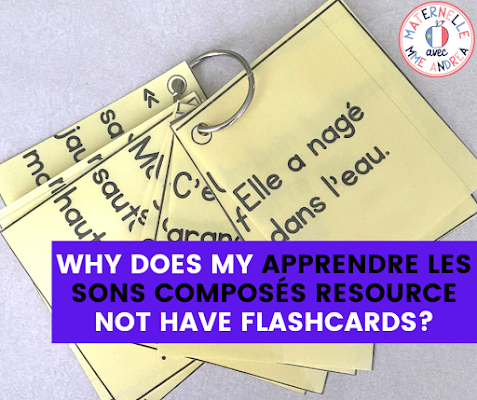Welcome to my first ever FAQ blog post!
I’m going to try and add more of these to my blogging schedule, to help answer questions that I get often in greater detail than sometimes the TPT Q&A feature allows for.
Today’s post will hopefully answer a question that I get a LOT via email & TPT!
This question pertains to my « Apprendre les sons composés » resource and one of the key differences between that product and the one that comes before it, « Apprendre les mots fréquents ».
In this blog post, I’ll explain exactly what this key difference is, and why I carefully made the choice to create these resources in this way.
You may already know this, but I have two resources that are kind of like mini “programs” that your students can move through to learn 90 common sight words and 9 common « son composés ».
These resources focus on 10 words/1 sound at a time, and as students move through each set of cards (in rainbow order), each list builds upon the last.
The « Apprendre les mots fréquents » resource contains :
- sight word cards in isolation (9 sets of 10 words)
- sight word cards in context (9 sets)
- a game
- word lists for the teacher
- evaluation sheets
- student certificates
The « Apprendre les sons composés » resource contains :
- son composé sentence cards (in context) – 9 different sets, each featuring one target sound
- cards with each sound in isolation (9 total cards)
- a game
- fluency passages
- word lists for the teacher
- evaluation sheets
- student certificates
So, what’s the big question?
The question I get most often about the « Apprendre les sons composés » resource is:
Why does the son composé resource not include cards with words containing the target sound in isolation?
The mots fréquents version has sets of flashcards with just the sight word in isolation. For example, liste rouge contains a flashcard for the words regarde, voici, maman, papa, dit, le, voici, c’est, grand and petit.
There is another set of cards with just these words in sentences, to help students learn to read them in context.
But, for the sons composé resource, rouge is for the sound « on », and there are no flash cards for words like : mon, ton, bonbon, wagon, etc. in isolation.
And lots of teachers want to know why!
The reason why the son composé set doesn’t include sets of flash cards with each word in isolation is because, unlike with sight words, the words in isolation are NOT what we want our students to memorize!
When it comes to les sons composés, what we actually want our students to do is remember that, when these 2+ letters are together in a word, they make a different sound.
We want them to know what to do when they come across that sound in a word, and be able to correctly decode it.
It’s impossible for our students to memorize every single word in the French language that contain each target sound, so we want to be sure we are giving them the TOOLS they need to be able to read new words that contain these sounds.
By not providing students with cards with these words in isolation, it encourages our students to decode the word using their new sound knowledge + think about what would make sense as they are reading, instead — which is much more helpful long-term!
You know — give a man a fish and he eats for a day, but teach a man to fish and he eats for life (or however that saying goes haha). We want to teach our students to read ALL words with the target sound, not just the 10 that we decide to put on flash cards.
The next question is…
So, if I don’t include flash cards for words with each target sound, you might be wondering why I include a list of words for each sound. And the answer is…
For the teacher!
You can use these lists to evaluate how well your students can decode them, as spelling lists/for spelling activities, etc.
But remember, we want our students to be able to READ words containing each target sound — not just memorize! This sets them up for more success down the road. So, I would never suggest sending the word lists home in their reading bags to “practice”, or anything like that.
These go-to word lists were intended to help you save time, and were never meant to be used to encourage students to memorize rather than read.
So, what are the sound flash cards for?
While we don’t want to encourage our students to try and memorize every word in the French language (learning to decode, aka READ, is so much more effective!), our students will need to memorize each sound.
That’s why there are cards with the sounds in isolation. Once students get to the third sounds list (jaune), I add a copy of each sound they have already seen to a ring for them to practice at home. I add the new sound cards each time they move on to the next colour.
We definitely want out students to understand that, when they see « oi » in a word, they need to say “wa” with their mouths, etc. etc. The sound flash cards can help make that automatic.
Looking for more ways to support your students with their sons composés?
This year, I’ve also made some desk strips with each of the 9 sounds that are featured in « Apprendre les sons composés » for my students. I just laminated them and stuck velcro to the back, added a piece of velcro to their desks, and they stick them to their desks (tape would work too!). They can more easily refer to them when they need to read or write each sound.
(Note: I stuck a little piece of masking tape to their desks first, and attached the velrco to that, to help me easily remove it at the end of the year. There is nothing I hate more than sticky desk residue!!)
If you want your own desk strips that match the 9 sounds studied in the Apprendre les sons composés resource, you can sign up to my email list and get it emailed to you by clicking HERE.
Just CLICK THE LINK, add your name & email, and I’ll send it straight to your inbox (sometimes it can take up to 10 minutes to arrive — be sure to check your spam if you don’t see it!).
Need even more resources?
If you’re looking for more resources to help you teach les sons composés, be sure to check out my TPT store – I have lots in there. You can see what I have to offer in my Sons composés category, or by clicking right HERE.





